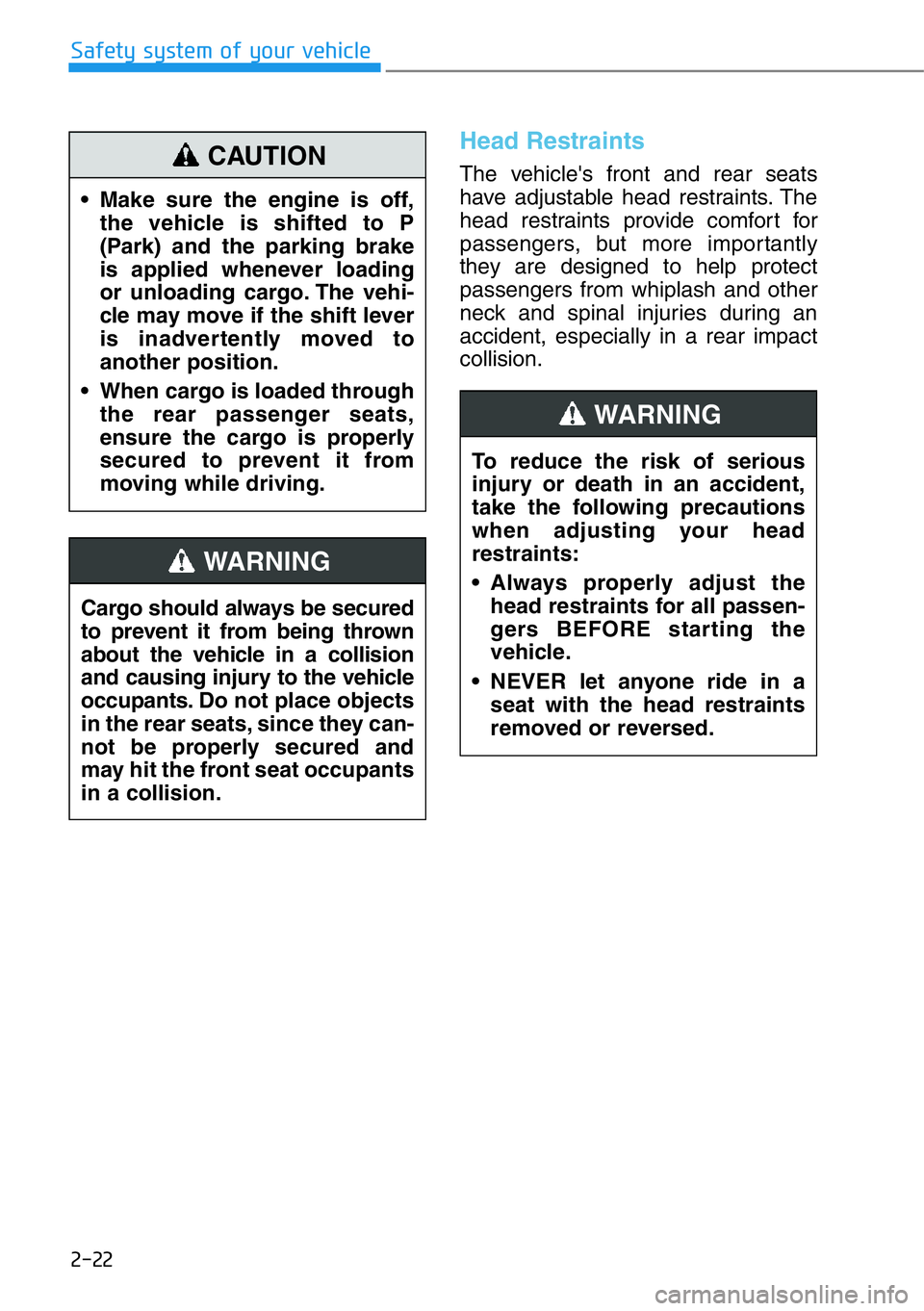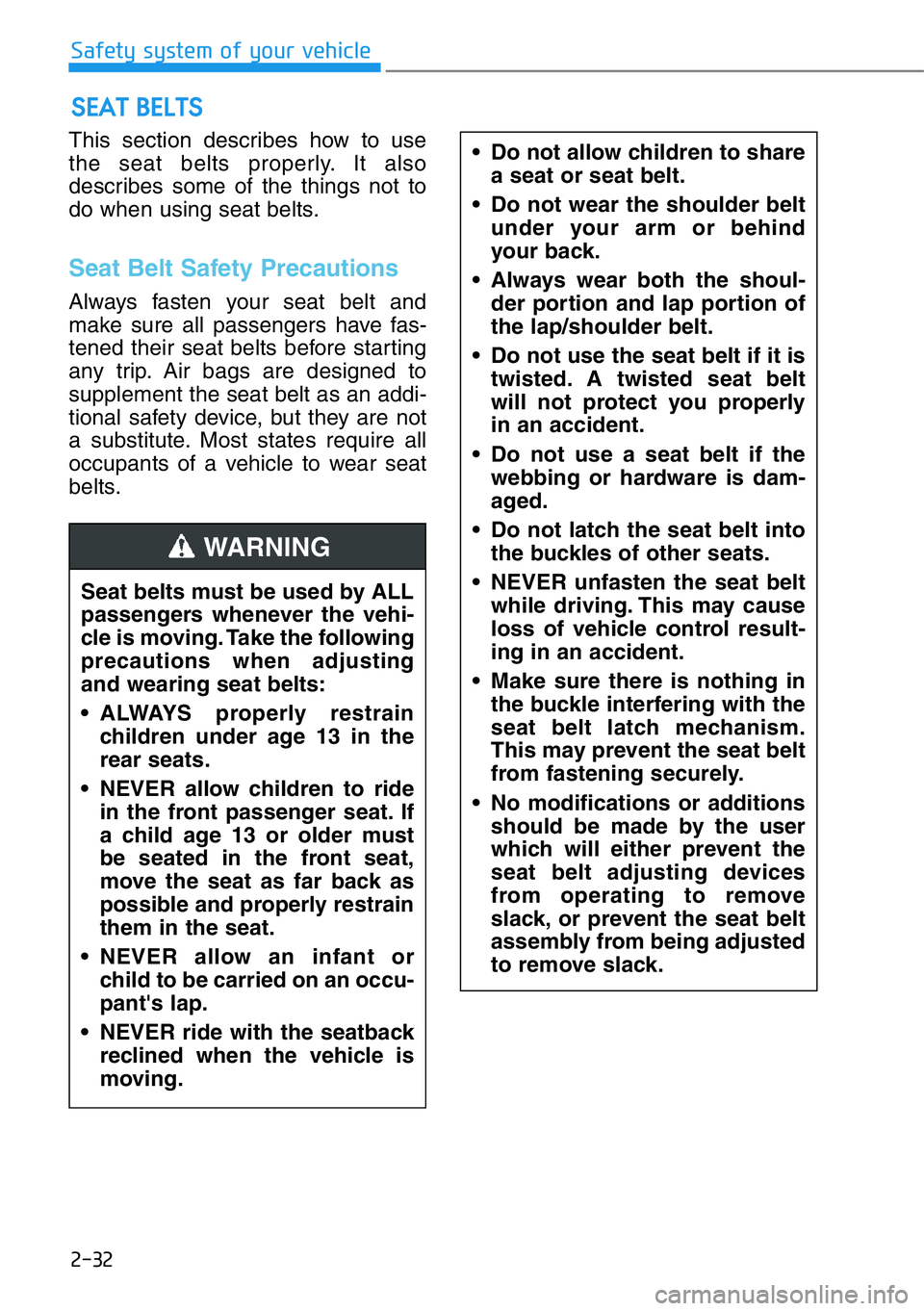remove seats GENESIS G90 2021 Owner's Manual
[x] Cancel search | Manufacturer: GENESIS, Model Year: 2021, Model line: G90, Model: GENESIS G90 2021Pages: 538, PDF Size: 13.02 MB
Page 42 of 538

2-22
Safety system of your vehicle
Head Restraints
The vehicle's front and rear seats
have adjustable head restraints. The
head restraints provide comfort for
passengers, but more importantly
they are designed to help protect
passengers from whiplash and other
neck and spinal injuries during an
accident, especially in a rear impact
collision.
To reduce the risk of serious
injury or death in an accident,
take the following precautions
when adjusting your head
restraints:
• Always properly adjust the
head restraints for all passen-
gers BEFORE starting the
vehicle.
• NEVER let anyone ride in a
seat with the head restraints
removed or reversed.
WARNING
Cargo should always be secured
to prevent it from being thrown
about the vehicle in a collision
and causing injury to the vehicle
occupants. Do not place objects
in the rear seats, since they can-
not be properly secured and
may hit the front seat occupants
in a collision.
WARNING
• Make sure the engine is off,
the vehicle is shifted to P
(Park) and the parking brake
is applied whenever loading
or unloading cargo. The vehi-
cle may move if the shift lever
is inadvertently moved to
another position.
• When cargo is loaded through
the rear passenger seats,
ensure the cargo is properly
secured to prevent it from
moving while driving.
CAUTION
Page 52 of 538

2-32
Safety system of your vehicle
This section describes how to use
the seat belts properly. It also
describes some of the things not to
do when using seat belts.
Seat Belt Safety Precautions
Always fasten your seat belt and
make sure all passengers have fas-
tened their seat belts before starting
any trip. Air bags are designed to
supplement the seat belt as an addi-
tional safety device, but they are not
a substitute. Most states require all
occupants of a vehicle to wear seat
belts.
SEAT BELTS
Seat belts must be used by ALL
passengers whenever the vehi-
cle is moving. Take the following
precautions when adjusting
and wearing seat belts:
• ALWAYS properly restrain
children under age 13 in the
rear seats.
• NEVER allow children to ride
in the front passenger seat. If
a child age 13 or older must
be seated in the front seat,
move the seat as far back as
possible and properly restrain
them in the seat.
• NEVER allow an infant or
child to be carried on an occu-
pant's lap.
• NEVER ride with the seatback
reclined when the vehicle is
moving.
WARNING
• Do not allow children to share
a seat or seat belt.
• Do not wear the shoulder belt
under your arm or behind
your back.
• Always wear both the shoul-
der portion and lap portion of
the lap/shoulder belt.
• Do not use the seat belt if it is
twisted. A twisted seat belt
will not protect you properly
in an accident.
• Do not use a seat belt if the
webbing or hardware is dam-
aged.
• Do not latch the seat belt into
the buckles of other seats.
• NEVER unfasten the seat belt
while driving. This may cause
loss of vehicle control result-
ing in an accident.
• Make sure there is nothing in
the buckle interfering with the
seat belt latch mechanism.
This may prevent the seat belt
from fastening securely.
• No modifications or additions
should be made by the user
which will either prevent the
seat belt adjusting devices
from operating to remove
slack, or prevent the seat belt
assembly from being adjusted
to remove slack.
Page 67 of 538

2-47
02
Selecting a Child Restraint
System (CRS)
When selecting a CRS for your child,
always:
• Make sure the CRS has a label
certifying that it meets applicable
Federal Motor Vehicle Safety
Standards (FMVSS 213).
• Select a child restraint based on
your child's height and weight. The
required label or the instructions
for use typically provide this infor-
mation.
• Select a child restraint that fits the
vehicle seating position where it
will be used.
• Read and comply with the warn-
ings and instructions for installation
and use provided with the child
restraint system.
Child restraint system types
There are three main types of child
restraint systems: rearward-facing
seats, forward-facing seats, and
booster seats. They are classified
according to the child’s age, height
and weight.
Rearward-facing child restraints
An improperly secured child
restraint can increase the risk
of SERIOUS INJURY or DEATH
in an accident. Always take the
following precautions when
using a child restraint system:
• NEVER install a child or infant
restraint in the front passen-
ger's seat.
• Always properly secure the
child restraint to a rear seat of
the vehicle.
• Always follow the child
restraint system manufactur-
er's instructions for installa-
tion and use.
• Always properly restrain your
child in the child restraint.
• If the vehicle head restraint
prevents proper installation of
a child seat (as described in
the child restraint system
manual), the head restraint of
the respective seating posi-
tion shall be readjusted or
entirely removed.
• Do not use an infant carrier or
a child safety seat that
"hooks" over a seatback, it
may not provide adequate
protection in an accident.
• After an accident, have retail-
er of Genesis Branded prod-
ucts check the child restraint
system, seat belts, tether
anchors and lower anchors.
WARNING
NEVER install a child or infant
restraint in the front passen-
ger's seat.
Placing a rearward-facing child
restraint in the front seat can
result in SERIOUS INJURY or
DEATH if the child restraint is
struck by an inflating air bag.
WARNING
Page 520 of 538

7-80
Maintenance
Interior Care
Interior general precautions
Prevent caustic solutions such as
perfume and cosmetic oil, from con-
tacting the interior parts because
they may cause damage or discol-
oration. If they do contact the interior
parts, wipe them off immediately.
See the instructions for the proper
way to clean vinyl.
• Never allow water or other liq-
uids to come in contact with
electrical/electronic compo-
nents inside the vehicle as this
may damage them.
• When cleaning leather products
(steering wheel, seats etc.), use
neutral detergents or low alco-
hol content solutions. If you use
high alcohol content solutions
or acid/ alkaline detergents, the
color of the leather may fade or
the surface may get stripped off.
Cleaning the upholstery and
interior trim
Vinyl (if equipped)
Remove dust and loose dirt from
vinyl with a whisk broom or vacuum
cleaner. Clean vinyl surfaces with a
vinyl cleaner.
Fabric (if equipped)
Remove dust and loose dirt from fab-
ric with a whisk broom or vacuum
cleaner. Clean with a mild soap solu-
tion recommended for upholstery or
carpets. Remove fresh spots imme-
diately with a fabric spot cleaner. If
fresh spots do not receive immediate
attention, the fabric can be stained
and its color can be affected.
Also, its fire-resistant properties can
be reduced if the material is not
properly maintained.
Using anything but recommended
cleaners and procedures may
affect the fabric's appearance and
fire-resistant properties.
NOTICE
NOTICE
Page 521 of 538

7-81
07
Leather (if equipped)
• Features of seat leather
- Leather is made from the outer
skin of an animal, which goes
through a special process to be
available for use. Since it is a nat-
ural product, each part differs in
thickness or density.
- Wrinkles may appear as a natural
result of stretching and shrinking
depending on the temperature
and humidity.
- The seat is made of stretchable
fabric to improve comfort.
- The parts contacting the body are
curved and the side supporting
area is high which provides driv-
ing comfort and stability.
- Wrinkles may appear naturally
from usage. It is not a fault of the
product.
• Wrinkles or abrasions which
appear naturally from usage are
not covered by warranty.
• Belts with metallic accessories,
zippers or keys inside the back
pocket may damage the seat
fabric.
• Make sure not to wet the seat. It
may change the nature of natu-
ral leather.
• Jeans or clothes which could
bleach may contaminate the sur-
face of the seat covering fabric.• Caring for the leather seats
- Vacuum the seat periodically to
remove dust and sand on the
seat. It will prevent abrasion or
damage of the leather and main-
tain its quality.
- Wipe the natural leather seat
cover often with dry or soft cloth.
- Use of a proper leather protector
may prevent abrasion of the
cover and helps maintain the
color.
- Be sure to read the instructions
and consult a specialist when
using leather coating or protec-
tive agents.
- Light colored(beige, cream beige)
leather is easily contaminated
and the stain is noticeable. Clean
the seats frequently.
- Avoid wiping with wet cloth. It may
cause the surface to crack.
NOTICE
Page 522 of 538

7-82
Maintenance
• Cleaning the leather seats
- Remove all contaminations
instantly. Refer to instructions
below for removal of each con-
taminant.
- Cosmetic products (sunscreen,
foundation, etc.)
Apply cleansing cream on a cloth
and wipe the contaminated spot.
Wipe off the cream with a wet
cloth and remove water with a dry
cloth.
- Beverages (coffee, soft drink,
etc.)
Apply a small amount of neutral
detergent and wipe until contami-
nations do not smear.
- Oil
Remove oil instantly with
absorbable cloth and wipe with
stain remover used only for natu-
ral leather.
- Chewing gum
Harden the gum with ice and
remove gradually.
• Handling prime napa leather
(if equipped)
Try to avoid excessive sunlight and
heat exposure. Excessive sunlight
and heat exposure naturally fades
and dries out napa leather, causing
wrinkles and discoloration. If the
napa leather is wet with liquid, imme-
diately clean it with lint-free cloth to
minimize damage. Do not scratch the
napa leather surface with a sharp
object. If your napa leather seat is
bright colored, it may be contaminat-
ed or stained from dyed materials
such as jeans.
Interior wooden trim
• Use a wooden furniture protector
(e.g. wax, coating compound) to
clean the interior wooden trim.
• Often wipe the interior wooden trim
with a lint-free, clean cloth to main-
tain the unique wooden textures for
a longer period of time.
• If you spill beverage (e.g. water,
coffee) over the interior wooden
trim, immediately wipe it with
clean, dry cloth.
• Sharp objects (e.g. driver, knife),
adhesive materials, or tapes
may damage the interior wooden
trim.
• Any strong impacts may dam-
age the interior wooden trim.
• If the coating finish over the
interior wooden trim is removed,
moisture may damage or
change wood traits.
• If the interior wooden trim is
damaged, you may get a splinter
from the wood surface.
Therefore, you should immedi-
ately have the damaged interior
wooden trim replaced by an
authorized retailer of Genesis
Branded products.
NOTICE